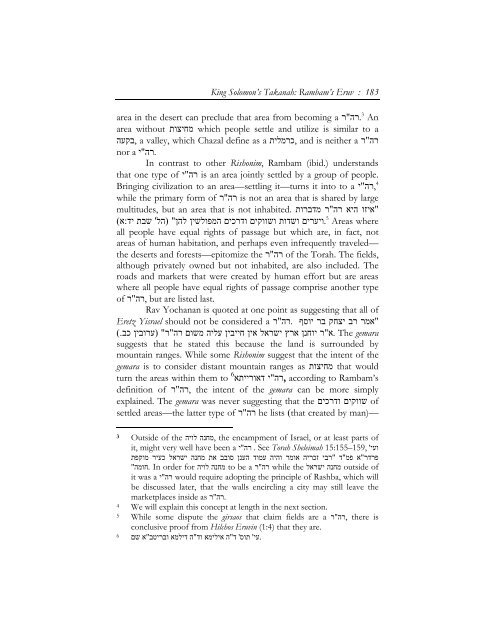King Solomon's Takanah: Rambam's Eruv - Hakirah.org
King Solomon's Takanah: Rambam's Eruv - Hakirah.org
King Solomon's Takanah: Rambam's Eruv - Hakirah.org
Create successful ePaper yourself
Turn your PDF publications into a flip-book with our unique Google optimized e-Paper software.
<strong>King</strong> Solomon’s <strong>Takanah</strong>: Rambam’s <strong>Eruv</strong> : 183<br />
area in the desert can preclude that area from becoming a .רה "ר 3 An<br />
area without מחיצות which people settle and utilize is similar to a<br />
and is neither a ,כרמלית a valley, which Chazal define as a ,בקעה<br />
.רה "י nor a<br />
In contrast to other Rishonim, Rambam (ibid.) understands<br />
that one type of רה "י is an area jointly settled by a group of people.<br />
4 ,רה "י Bringing civilization to an area—settling it—turns it into to a<br />
while the primary form of "ר is not an area that is shared by large<br />
multitudes, but an area that is not inhabited. "<br />
( . 5 Areas where<br />
all people have equal rights of passage but which are, in fact, not<br />
areas of human habitation, and perhaps even infrequently traveled—<br />
the deserts and forests—epitomize the "ר of the Torah. The fields,<br />
although privately owned but not inhabited, are also included. The<br />
roads and markets that were created by human effort but are areas<br />
where all people have equal rights of passage comprise another type<br />
of "ר , but are listed last.<br />
Rav Yochanan is quoted at one point as suggesting that all of<br />
"ר Eretz Yisrael should not be considered a<br />
. " ( . The gemara<br />
suggests that he stated this because the land is surrounded by<br />
mountain ranges. While some Rishonim suggest that the intent of the<br />
gemara is to consider distant mountain ranges as מחיצות that would<br />
6<br />
turn the areas within them to<br />
, according to Rambam’s<br />
definition of "ר , the intent of the gemara can be more simply<br />
explained. The gemara was never suggesting that the שווקים ודרכים of<br />
settled areas—the latter type of "ר he lists (that created by man)—<br />
רה "ר<br />
רה<br />
רה<br />
איזו היא רה"ר מדברות<br />
ויערים ושדות ושווקים ודרכים המפולשין להן" (הל' שבת יד:א<br />
רה<br />
אמר רב יצחק בר יוסף רה<br />
א"ר יוחנן ארץ ישראל אין חייבין עליה משום רה"ר" (ערובין כב.<br />
רה "י דאורייתא<br />
רה<br />
רה<br />
3 Outside of the לויה ,מחנה the encampment of Israel, or at least parts of<br />
ועי ' 15:155–159, . See Torah Sheleimah רה "י it, might very well have been a<br />
פרדר"א פמ"ד "רבי זכריה אומר והיה עמוד הענן סובב את מחנה ישראל כעיר מוקפת<br />
חומה<br />
מחנה יש while the "ר<br />
" . In order for מחנה לויה to be a רה ראל outside of<br />
it was a רה "י would require adopting the principle of Rashba, which will<br />
be discussed later, that the walls encircling a city may still leave the<br />
"ר marketplaces inside as<br />
. 4 We will explain this concept at length in the next section.<br />
5 While some dispute the girsaos that claim fields are a "ר ,רה there is<br />
conclusive proof from Hilchos <strong>Eruv</strong>in (1:4) that they are.<br />
רה<br />
. ' תוס' ד"ה אילימא וד"ה דילמא ובריטב" א שם<br />
עי 6
















